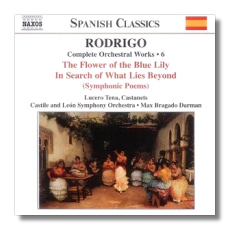
The Internet's Premier Classical Music Source
Related Links
- Rodrigo Reviews
- Latest Reviews
- More Reviews
-
By Composer
-
Collections
DVD & Blu-ray
Books
Concert Reviews
Articles/Interviews
Software
Audio
Search Amazon
Recommended Links
Site News
 CD Review
CD Review
Joaquín Rodrigo

Complete Orchestral Works, Volume 6
– Symphonic Poems –
- Per la flor del lliri blau
- A la busca del más allá
- Palillos y panderetas
- Dos danzas españolas
- Tres viejos aires de danza
Lucero Tena, castanets
Castile and León Symphony Orchestra/Max Bragado Darman
Naxos 8.555962 DDD 68:52
This is Volume 6 in Naxos' series of the complete orchestral works of Joaquín Rodrigo. This series is a well-planned, well-executed, and inexpensive introduction to the fact that this composer wrote a great deal more than the (deservedly) popular Concierto de Aranjuez.
The major works on this CD are Per la flor del lliri blau (The Flower of the Blue Lily) and A la busca del más allá (In Search of What Lies Beyond). The former, composed in 1934, is based on a Valencian fable about a dying king who sends his three sons to find a flower that will restore him to health. The youngest son finds it, but he is killed by his jealous brothers. (This sounds like Shakespeare's King Lear meets Mahler's Das klagende Lied!) Rodrigo's symphonic poem finds him in an unusual story-telling mode, and his talent for brilliant color is put to the service of a narrative, all to good effect. The latter was a commission by the Houston Symphony to celebrate the United States's bicentennial; it is dedicated to NASA. Appropriately, Rodrigo's response to the "outerwordly" topic was to write mysterious, softly glittering music in the manner of Holst's "Neptune" (from The Planets) and Vaughan Williams' Sinfonia Antarctica. Rodrigo flirts with a more modern sound (including moments of atonality) to reflect the awesome uncertainties of outer space, but when the music eventually blossoms melodically, the result is just as romantic and hopeful as an episode of "Star Trek: The Next Generation."
The other three works are less important, but they rest no less easily on the ear. They were written over a period of over fifty years. Tres viejos aires de danza (Three Traditional Dance Airs) date back to the late 1920s, while Palillos y panderetas (Castanets and Tambourines) dates from 1982, the year before the composer's retirement. The middle work, Dos danzas españolas (Two Spanish Dances) features a virtuoso castanet part, here played by Lucero Tena, whose name appears on more than one recording of Carmen in my collection! (Tena was the dedicatee of this work, which was composed in 1966.) It appears that the composer's goal in these three works was to write colorful, rhythmic music in a nationalistic style, and to make it simple enough to be enjoyed by the average José . No one can say he didn't succeed, and if the results aren't deeply sophisticated, so what?
As with earlier volumes in this series, the regional orchestra, associated with Valladolid, does itself proud. The performances aren't free of minor technical mishaps, but given Rodrigo's brilliant, life-enhancing writing, there isn't enough time to worry about them. Full speed ahead!
Copyright © 2003, Raymond Tuttle


















